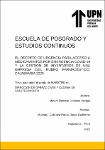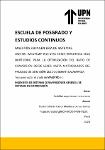Mostrar el registro sencillo del ítem
Current situation of Covid-19 and its impact on phubbing and student performance
| dc.contributor.author | Uceda, Patricia | |
| dc.contributor.author | Bazán, Laura | |
| dc.contributor.author | López, Rosa | |
| dc.date.accessioned | 2021-07-12T21:00:43Z | |
| dc.date.available | 2021-07-12T21:00:43Z | |
| dc.date.issued | 2021-06-15 | |
| dc.identifier.citation | Uceda, P., Bazán, L., & López, R. (2021). Current situation of Covid-19 and its impact on phubbing and student performance. Proceedings of the 6th Brazilian Technology Symposium. Smart Innovation, Systems and Technologies, 233, 130-136. https://doi.org/10.1007/978-3-030-75680-2_16 | es_PE |
| dc.identifier.uri | https://hdl.handle.net/11537/27167 | |
| dc.description | El texto completo de este trabajo no está disponible en el Repositorio Académico UPN por restricciones de la casa editorial donde ha sido publicado. | es_PE |
| dc.description.abstract | ABSTRACT The use of smartphones and the Internet increasingly affects people’s lives, thereby establishing new forms of communication. Digital tools are necessary for performance and social interaction. This research study sought to identify the impact of the COVID-19 pandemic on the performance of the first year of computational systems engineering at the Universidad Privada del Norte – Cajamarca, specifically with regard to phubbing. The study was nonexperimental in nature, followed a correlate descriptive approach, and was of longitudinal design with two observations (cycles 2019-2 and 2020-1). The Chotpitayasunondh and Douglas measurement scale was used for the assessment of phubbing, which was validated in pilot testing (α = 0.8512). Academic performance was obtained from the final averages of the Programming subject, where the phubbing survey was applied with the voluntary participation of students. Correlation results determined no positive relationship between phubbing level and performance level; hence, the variable situation of the COVID-19 pandemic, which modified the academic space, was analyzed in accordance with the needs associated with this environment and the life of students. The level of phubbing in students decreased from 40.33% to 35.51%, while their performance level increased from 12.98 and 13 to 14.48 and 15 in terms of average and median, respectively. The aspects of phubbing were evaluated with a coherent perception, reaffirming the validity of the instrument. Educational policies that promote positive smartphone use are required to improve academic performance. | es_PE |
| dc.format | application/pdf | es_PE |
| dc.language.iso | eng | es_PE |
| dc.publisher | Springer | es_PE |
| dc.rights | info:eu-repo/semantics/openAccess | es_PE |
| dc.rights | Atribución-NoComercial-CompartirIgual 3.0 Estados Unidos de América | * |
| dc.rights.uri | https://creativecommons.org/licenses/by-nc-sa/3.0/us/ | * |
| dc.source | Universidad Privada del Norte | es_PE |
| dc.source | Repositorio Institucional - UPN | es_PE |
| dc.subject | Smartphones | es_PE |
| dc.subject | Rendimiento académico | es_PE |
| dc.subject | Covid-19 | es_PE |
| dc.subject | Estudiantes universitarios | es_PE |
| dc.title | Current situation of Covid-19 and its impact on phubbing and student performance | es_PE |
| dc.type | info:eu-repo/semantics/conferenceObject | es_PE |
| dc.publisher.country | CH | es_PE |
| dc.identifier.journal | Proceedings of the 6th Brazilian Technology Symposium | es_PE |
| dc.subject.ocde | https://purl.org/pe-repo/ocde/ford#2.02.04 | es_PE |
| dc.description.sede | Cajamarca | es_PE |
| dc.identifier.doi | https://doi.org/10.1007/978-3-030-75680-2_16 |
Ficheros en el ítem
| Ficheros | Tamaño | Formato | Ver |
|---|---|---|---|
|
No hay ficheros asociados a este ítem. |
|||





